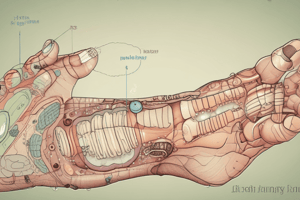Podcast
Questions and Answers
Where is the spleen reflex located?
Where is the spleen reflex located?
How should the spleen reflex be massaged?
How should the spleen reflex be massaged?
What are the five parts of the colon reflex?
What are the five parts of the colon reflex?
Where is the small intestine reflex located?
Where is the small intestine reflex located?
Signup and view all the answers
How should the lymph reflex points be massaged?
How should the lymph reflex points be massaged?
Signup and view all the answers
Study Notes
- The spleen is a secondary lymphoid organ that regulates the amount of B cells used during immune responses.
- The spleen reflex is located in the fifth zone proximal to the head of the fifth metatarsal and proximal to the diaphragm reflex at the lateral plantar fascia and abductor digiti minimi muscle.
- Massage the spleen reflex using circular or back-and-forth, friction motions.
- The stomach reflex is located in the first zone along the first metatarsal proximal to the diaphragm reflex along the digital slip of the plantar aponeurosis and flexor hallucis brevis muscle.
- Stimulate the stomach reflex using reverse “C” motion, and massage the right foot using “C” motion.
- The pancreas is both an endocrine gland that releases hormones to regulate blood glucose levels and an exocrine gland that secretes digestive enzymes.
- The pancreas reflex is located deeper to the stomach reflex proximal to the head of the first metatarsal in the central area of the stomach reflex at the flexor hallucis brevis muscle.
- Massage the pancreas reflex using back-and-forth, friction and deep, press-and-release motions.
- The adrenal glands are part of the HPA axis and secrete the stress hormones cortisol, epinephrine and norepinephrine.
- The adrenal glands reflex is located in line with the second toe just below the diaphragm reflex.
- Find the kidney reflex by sliding your finger from the second toe toward the heel until you feel the indention proximal to the head of the second metatarsal.
- Massage the kidney reflex using deep, effleurage motions in a proximal direction from the kidney to the bladder.
- The ureters are tubes that connect the kidneys to the bladder.
- The ureters reflex begins in the second zone proximal to the kidney reflex and travels from the kidney reflex toward the bladder reflex, where it crosses into the first zone.
- Massage the ureters reflex using deep, effleurage motions in a proximal direction from the kidney to the bladder.
- The five parts of the colon reflex are the ascending colon reflex, the transverse colon reflex, the descending colon reflex, the sigmoid colon reflex, and the rectum reflex.
- The ascending colon reflex begins in the fifth zone just distal to the heel along the lateral band of the plantar aponeurosis and abductor digiti minimi muscle.
- The transverse colon reflex stretches across these muscles until the level of the tuberosity of the fifth metatarsal, at which point the reflex is the hepatic flexure of the colon.
- The transverse colon continues on the left foot at the inside arch and stretches across to the fourth zone at the level of the tuberosity of the fifth metatarsal.
- In the fifth zone, the reflex is the splenic flexure of the colon and moves distally to the spleen reflex.
- The transverse colon reflex becomes the descending colon reflex and moves proximal in the fifth zone toward the calcaneus.
- The descending colon reflex becomes the sigmoid colon reflex just distal to the heel and moves medially to the first zone along the tendon of the flexor digitorum brevis muscle.
- The sigmoid colon reflex becomes the rectum reflex and ends at the medial end of the tendon of the flexor digitorum brevis muscle.
- Massage the colon reflex using effleurage motions.
- On the right foot, begin at the ascending colon reflex, and move medially along the transverse colon reflex.
- On the left foot, begin at the transverse colon reflex, move laterally to the descending colon reflex, then proximal to the sigmoid colon reflex, then medially along the sigmoid colon reflex to the rectum reflex.
- Use circular, friction motions on any tense areas.
- Spend extra time on the hepatic and splenic flexures, as these are often the most congested areas.
- The small intestine reflex is located in the center area formed by the colon reflex at the plantar aponeurosis and flexor digitorum brevis muscle.
- Massage the left foot in lateral and medial directions, and massage the right foot in proximal and distal directions.
- The lymph reflex points are located on the posterior side of the ankle on either side of the calcaneal tendon, between the big toe and the second toe, and on top of the foot between the heads of the metatarsals.
- The breast reflex is located on top of the foot distal to the heads of the metatarsals. Massage this reflex using circular, friction motions.
Studying That Suits You
Use AI to generate personalized quizzes and flashcards to suit your learning preferences.
Description
Learn about reflexology massage techniques to stimulate the spleen, stomach, pancreas, adrenal glands, kidneys, ureters, colon, small intestine, lymph reflex points, and breast reflex on the feet. Discover the specific reflex locations and massage motions to improve organ health and overall well-being.




